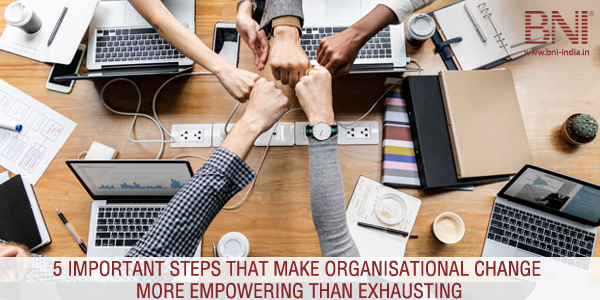How often have you heard the phrase, ‘Change is Constant’? Multiple times…? More often than you can remember..? How often do you embrace change wholeheartedly? This must be easy to answer. Never.? Change especially when imposed is quite hard to adapt to. Organisational change, unlike self-transformation, is imposed but an organisational change like any other change is constant. More so in a dynamic business world, which is driven by constantly evolving technology, change isn’t an option.
Let’s look at why organisational change is hard.
Jim Hemerling, Organisational Change Expert, believes it is so because the leaders make it hard in two ways-:
- By delaying communication of the change: The leaders wait to address their team till it’s too late and the whole company is in crisis mode; in crisis, change is going to be nothing less than exhausting.
- They are short-sighted & inactive: A crisis mode may get the team to adapt to the change quickly and just focus on short-term results which don’t influence a better or promising future. Or they might just have a superficial, one-off approach which involves just waiting for the crisis situation to dissolve on it’s own-this can get employees frustrated and their natural reaction to change would be negative.
Jim shares 5 ways in which we can make organisational change easy for the leaders & empowering for the employees. He believes one common idea weaves these 5 together and that is- Putting People First.
- Inspire Through Purpose: While financial goals are integral to a company’s growth using them to motivate change could be hard on people; but if leaders can connect change towards a better or more promising future for the community, it could work. Jim gives the example of Lego where every new product line or expansion is connected to giving millions of children access to Lego building bricks and giving children an opportunity to experience the joy of learning through play. Such a deep sense of purpose highly motivates employees to embrace & adapt to change.
- Go All In: When it comes to organisational change, companies limit themselves to downsizing or cutting overheads. But Jim asks leaders to go all in initiatives that will help them win in the medium term, drive growth & develop leadership & the talent. He encourages them to look at transforming fundamental ways of working in the organisation.
- Enable People With Capabilities Needed to Succeed During & Post Transformation: He cites the example of a leading software company called Chronos who made the shift from building software products to offering software services. To enable this change, they invested in tools that would help employees monitor the usage features of a product & and customer satisfaction with the product. They also invested in skill development & reinforced the role of collaborative behaviours that would be required to deliver end-to-end seamless customer service.
- Instil A Culture Of Continuous Learning: Jim talks about how Microsoft CEO, Satya Nadella, enabled his employees to shift from the fixed mindset to a growth mindset by nurturing a constant, living, learning environment. Microsoft employees adapted to the growing mobile-first world; and this was done, clearly, by putting people first.
- Inclusive Leadership: Open debates, solicited suggestions, a question like ‘What are you saying, that I am Missing?’ would always go a long way. Jim encourages leaders to listen to their employees and gives them due credit time & again for their efforts.
“We owe to ourselves, our organisations and to the society, broadly, to boldly transform our approach to transformation. To do that, we need to start putting people first”-Jim Hemerling
